Transmission from the depths of the sea: 800 km long NEPTUNE channel holds the Internet to the bottom of the ocean

Your home Ethernet cable on your desktop doesn't have to deal with the different inhabitants of the oceans, such as this starfish, for example.
The tectonic plate of Juan de Fuca is today one of the smallest in size on Earth. It is located a few hundred kilometers from Oregon, Washington and the coast of British Columbia. However, the shortcomings in size Juan de Fuca pays off its sociability. It became home to a unique, high-speed optical cable network that found its way through the deep bottom of the Pacific Ocean at the end of 2009.
This channel was called the NEPTUNE - the North-East Pacific Time-Series Underwater Networked Experiment (North-East Pacific Underwater Experimental Network without temporary interruptions - approx. Translator ). Its length is more than 800 kilometers, which is comparable to the length of 40,000 subway cars, coupled into one, long train.
A team of scientists, researchers and engineers from the nonprofit group Oceans Network Canada supports the network, the implementation of which cost 111 million Canadian dollars, and annual support - 17 million. It should be noted here that we are dealing with an unusual submarine cable. Unlike such cables, instead of crossing the entire ocean floor, NEPTUNE goes back to the coast - to the very place where it starts. And although NEPTUNE is designed to improve the transfer of information across the ocean, it also collects information about it and the life at its bottom.
')
So forget about the Internet of Things: NEPTUNE has connected a whole tectonic platform to the Internet.
The deep sea - the last frontier
Professor of Oceanography, John Delaney of the University of Washington, proposed the idea of NEPTUNE in the mid-1990s, anticipating that the subsequent speedy development of the Internet would have a much broader meaning than the connection between home and office computers. He suggested that "distributed networks of automated sensors in the oceanic environment" would monitor the seas continuously, using methods that researchers on ships go to sea at certain short intervals of time can hardly imagine or allow.
Returning to our day, we will see that continued support of communication with the seabed is still a considerable achievement. Despite the fact that we have long ago mastered the ability to maintain wireless communication with satellites and spacecraft at a distance of billions of kilometers from us, the depths of the ocean are different, just opened the line for development. To begin with, it is worth noting that there are no wireless communications in the water - everything must be wired, waterproof and protected from risk factors such as an accidentally dropped anchor, corrosion and leakage. In this regard, Juan de Fuca is also a significant threat: about 400 earthquakes occur on the plate every year.
Incredibly, Ocean Networks Canada managed to make the whole system work. Five deep-sea locations throughout NEPTUNE serve as a place for a huge number of sensors and instruments: from tsunami recognition systems for seismic surveys to measuring the amount of greenhouse gases in an ocean ecosystem. The deepest of the locations, the sixth, which lacks funding for continuous observation, is located at the very edge of the Juan de Fuca platform at a depth of 2.4 km below the ocean surface - almost as deep as the Alcatel-Lucent submarines laying NEPTUNE cables can dive.
Each of the locations right now, up to a second, provides valuable information about the health of our oceans and the planet as a whole, using methods that scientists on the surface of the sea can only dream of in just a few weeks of summer. By connecting this network to the Internet, we get the opportunity to watch, relay and analyze this information in real time, worldwide. This is the absolute realization of Delaney’s vision and one of the most important tasks of NEPTUNE.
However, launching NEPTUNE for real-time operation and maintaining it in this state was not an easy task. Based on several years of the project, we can safely say that people have never invented computer networks that would work at such depths.

NEPTUNE project coverage map
Gasket and launch
Wally is a robot, about the size of a small refrigerator. He travels along the bottom of the Pacific. His cable allows him to move within 70 meters in any direction. Together with the bottom flora and fauna, it lives in the zone of geothermal faults, which its operators tenderly nicknamed “Wallyland”. This title clearly reads a hint of an amusement park, unless of course your idea of entertainment is a greenhouse full of bacteria and gas hydrates - durable formations of icy methane that are stable only at a depth of at least a kilometer below sea level. Here in this place Wally lived for almost two years.
Wally does not look like ordinary robotic underwater crawlers: they usually do not stay under water for such a long time. Even the scientists who control them do it in the most unusual way - with the help of a remote control, via the Internet, from the other end of the planet. Thanks to NEPTUNE, the crawler is permanently connected to the network, receives power from the shore and is available 24 hours a day, 7 days a week, throughout the year.
Geophysicist Martin Squerwot, who is a kind of liaison between Wally and his operators far in Germany, does not know of any other deep-sea crawler that would work in a similar way. Apparently, the point here is that companies such as Alcatel-Lucent, as a rule, do not carry out any work in places that Wally and other NEPTUNE devices call their home.
“We wanted to lay the cables in places that we usually avoid when laying, where they would never be put,” recalls Kim Juniper. This marine microbiologist is the research director of Ocean Networks Canada, acting as an intermediary between the cable network and scientists from around the world involved in the development of the instruments that his team uses, such as Wally. From 2004 to 2006, as chief scientist, he worked on the design of the NEPTUNE cable route in close collaboration with Alcatel-Lucent.
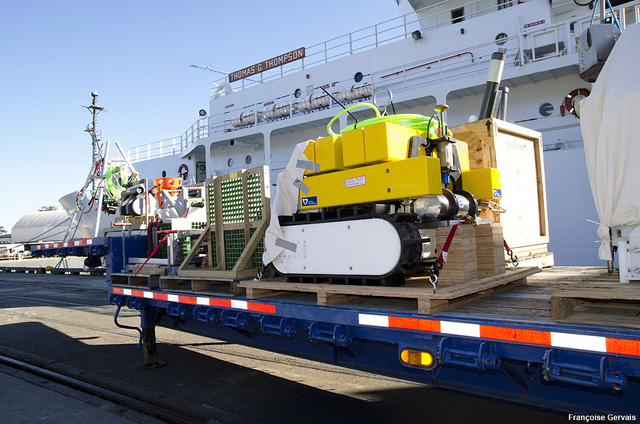
Wally riding a cargo platform
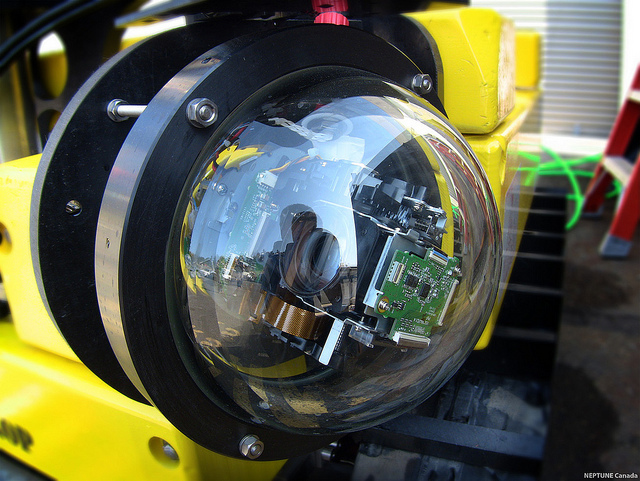
Spare camera Wally. Watch what Wally sees online.
In his office, in the smelly damp, tree-littered campus of the University of Victoria, which Ocean Networks Canada is calling its home, Juniper, dressed in a strict shirt with a wide tie, today looks more like an office manager than an oceanographer. In order to show me everything clearly, he unfolded a spacious map of the submarine network, which turned out to be much larger than his table.
The trunk cable carries a tremendous amount of energy - 80 kW, 8 kW of electricity and a 4 Gbit channel for each location. On the gap to the edge of the continental shelf, where the depth reaches just over 400 m, the cable is covered with an armored shell and with it reaches a diameter of 3.8 cm. With the help of a plow, it digs into the ocean floor to a depth of at least one meter, eventually reaching the depth of the strip more than 1.2 km at the maximum distance from the coast.
However, the probability of a break is always there, and it was here that the intention to realize the network as a loop came to the rescue. Juniper cannot say exactly when this idea appeared, however, according to his supposition, the unfriendly environment of the ocean played its role. The idea is that instead of pulling a long cable into the ocean, leaving its end somewhere in the abyss of the sea, the cable loops back to the coast station where it begins. And since power and information circulate in both directions, in the event of any breakdown or equipment malfunction, the team can reconfigure NEPTUNE to compensate for the consequences of the failure. And even though the network in this state can only work at half its speed, it offers a level of fault tolerance that most submarine cables do not have.
Further, at each of the six locations along the mainline - Berkeley Canyon, the Endeavor Mountain Range, the Folger Channel, Cascadia Bay, the Clayquot Slope and Middle Valley, the cable is divided into secondary cables, which are called "branches". These branches are very important, as they help NEPTUNE to go where Alcatel-Lucent does not dare to go - areas where there are bare rocks on the bottom surface, geothermal wells and often landslides. Each process leads to a node that is best imagined as a huge underwater network switch that provides undervoltage power and provides information communication with the NEPTUNE infrastructure of the second level, consisting of sensors and platforms with devices.
“Alcatel-Lucent has never tried to transfer electricity and connect devices with cables directly under water,” says Juniper, “Opening your submarine cables to the rest of the world is the last thing they want to do.”
However, the ability to connect devices to the network and disconnect them under water is key for the entire project. At each of the five working NEPTUNE locations (devices are installed on the sixth, but there is no funding), there are devices called switching boxes. Switching boxes receive low-voltage power from nodes, connect to their information cables and distribute them further to instrumentation platforms (where there are usually many sensors), transmit them to crawlers and devices with high bandwidth requirements, such as hydrophones and cameras. Virtually all of this can be plugged into the network or disconnected from it right under the water, with the help of remotely controlled underwater technology, which allows the maintenance team to make improvements and install new devices without making any changes to the fundamental elements of the network.
The result is a confusion of auxiliary cables, quite similar to the situation with the wires of your home router, only under water and with a total length of almost 90 km.
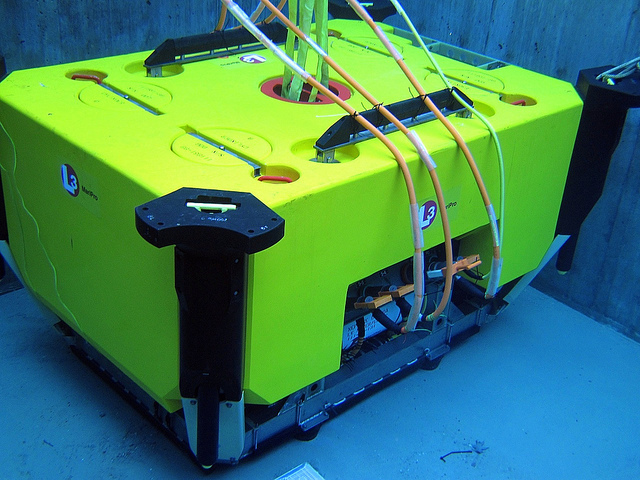
This is what a close-up node looks like in a test tank.
“We have always forced Alcatel-Lucent out of its comfort zone. We ask them about it and they do it, for the sake of science. I think, however, that in the future they will use much more conservative solutions when laying telecommunication cables, in particular, such volcanic areas will be avoided, ”Juniper laughs.
Well, the NEPTUNE team, on the contrary, has no choice. All off-site equipment, from cables to high-resolution cameras, is owned by Ocean Networks Canada. And it is in such inhospitable environments that observation is most needed.
Unusual maintenance
Canadian border ship John P. Tully is considered a “small” ship. Built in 1984 and named after the famous Canadian oceanographer, it reaches 65 meters in length. However, a walk on the equipment-loaded Tally decks before sailing in early May is stunning. The amount of technical equipment that the team has packed into it will dramatically change your idea of the true size of the ship.
A remote-controlled underwater vehicle called the Oceanic Explorer, the size of a compact SUV, sits aft, with wires stretched across the deck. Nearby there are two cargo containers, inside of which are the control center of the apparatus and the control panel of the satellite communication system. Inside the ship, folded to the ceiling and connected with a rope, there are racks with imaging and broadcasting equipment, and most of the wooden surface is dotted with holes for screws screwed in to fix smaller electronics.
Twice a year, during several weeks of sailing under the name “Installation of the Abyss”, carried out for the implementation of technical works, the Director of the observation operations Adrian Round calls the similar vessels his home. Slender white beard Round well acquainted with life at sea. Now, a retired commander of the Canadian Navy Algonquin and commander of the Esquimalt base on Vancouver Island near Victoria, he spent 26 years in the Canadian navy. And now he has been working with Ocean Networks Canada for 10 years.
Given that the primary infrastructure has long been established, this year’s voyages are almost entirely devoted to servicing the secondary network infrastructure: you need to get the instruments to the surface, clean the equipment, calibrate the old sensors and lower the new ones. Despite the fact that the presence of journalists on this voyage is not provided for, the Round more than willingly makes an introductory tour of Tally, while the last lots of equipment are moved to the deck with the help of hands, cranes and lifts.
NEPTUNE exists thanks to instruments and their sensors - electronic tentacles, constantly monitoring, collecting information about water and life on the seabed. As a rule, they are contained in protective structures, in a conversation referred to simply as "banks." There are both banks to protect power and network equipment in the NEPTUNE nodes, and banks for devices distributed throughout the depth. These structures are filled with either air with a pressure indicator on the surface or an oily incompressible fluid that protects the electronics inside.
The irony is that the sea water here is both an assistant and a hindrance: the banks are designed not only to use the peculiarities of sea water for their own purposes, but also to resist its negative influence. Despite the fact that the entire network is grounded to sea water, and the ocean is also a good conductor of heat, sometimes electricity behaves in relation to water not in the way that NEPTUNE engineers conceived. When the voltage goes out of the device not as it should, a short circuit to seawater may occur. The network is of course designed with a certain margin of safety in case of such leaks, but no more. If you do not isolate or disconnect the devices in time, a short circuit can burn holes in the walls of structures under pressure, making the equipment vulnerable to the sea.
There are other cases where corrosion corrodes the material. "Everyone thinks, 'Oh, well, just make everything stainless steel!' However, if you leave stainless steel near the surface covered with hydrothermal cracks, after a few months nothing will be left, ”explains Round,“ Therefore, instead of stainless steel, we use titanium. Well, if you do not fall below 1000 m, we can safely use plastic covers. "
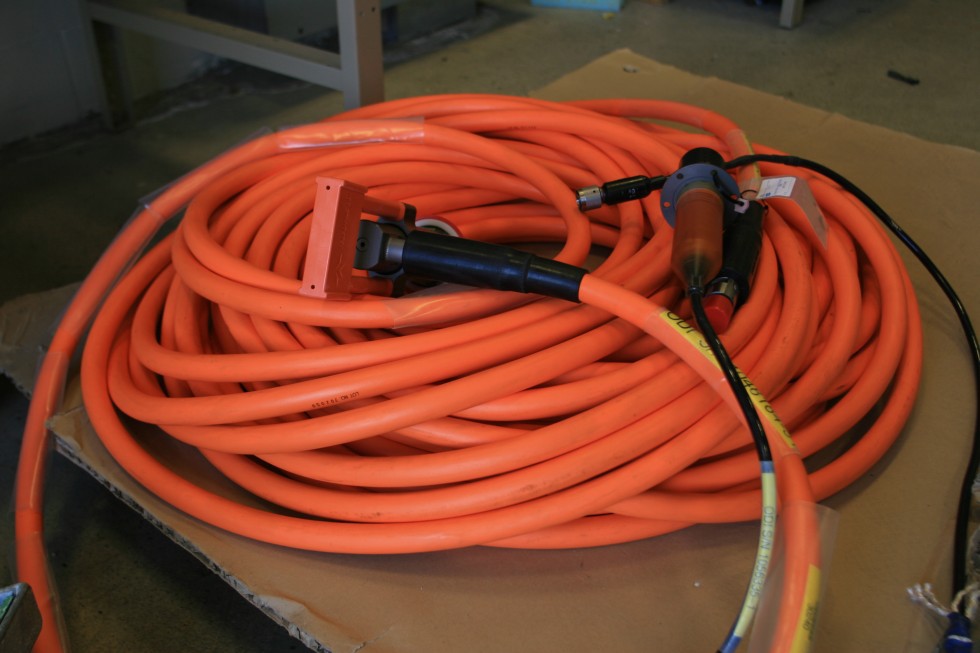
The first such waterproof Ethernet cables that NEPTUNE uses were invented by companies in the oil and gas industry.
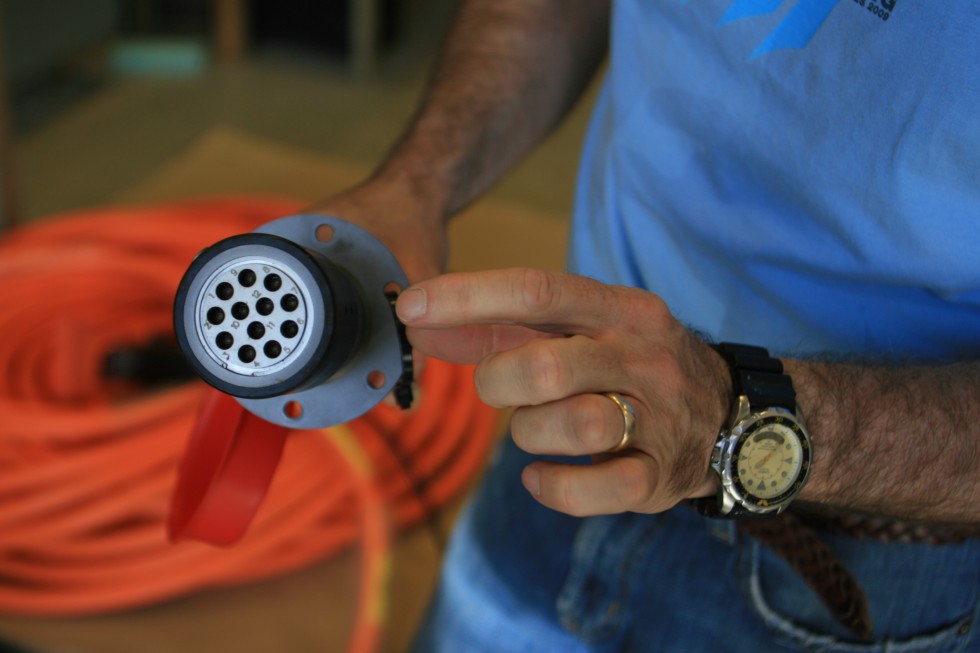
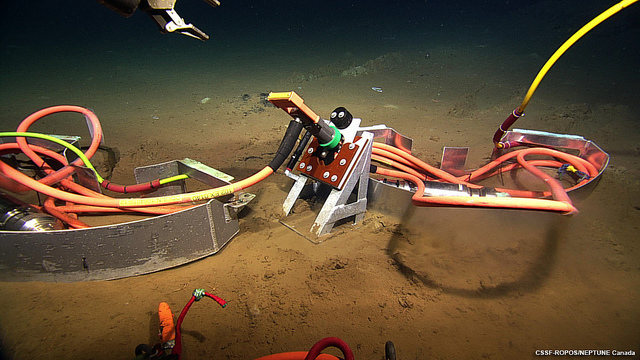
Cable connection example
Most of these metal and plastic products Round with their team made their own, in the Center for Marine Technology nearby. Much was done for the first time and it was not always possible to find prefabricated parts, but the cables that connect the devices, junction boxes and NEPTUNE nodes were in fact already invented by the oil and gas industry, so they were available for purchase. At the end of a large rubber cable that the Round holds in its hands is a connector resembling a fire hose hose, but with gold-plated contacts inside it arranged in concentric circles.
Before they are electrically connected down to the bottom, these gold-plated contacts go through what the Round describes as oil baths and water removal, because when there is “no salt water, there are no problems”. The result is the same as the inclusion of the Ethernet cable in the back panel of your router, with the only exception that, in the case of Adrien, all the work is performed onboard the Talley operator of the underwater remote control, controlling the robot arm.
The sleeves are filled with silicone oil, an incompressible fluid, which eliminates the possibility that the cable may burst at lower depths. Round really would not want to, because these cables are not cheap. Only one pair of connecting copper Ethernet connectors can cost $ 25,000 and this amount doubles if the network requires lengthening of fiber optic cables and new connectors that are required to connect to instrument platforms and junction boxes, in case the distance between them exceeds 70 m. Some of these satellite sites operate at a distance of several kilometers. To save money, wherever possible, NEPTUNE use dry pairs of connectors. They cost only $ 2500 per pair and are made of titanium, which is preferable for a depth of more than 400 m. The disadvantage of their use is that they can only be joined on land.
However, the Round understands that they will never be able to eliminate all risks, especially unforeseen risks. Last year, the boat took down the roof of the vertical profiler - a device that moves with the help of a cable from the seabed to the surface, collecting information about the water column at various depths. Crawler Wally, once, for several alarming weeks stuck in a layer of mud. And in the first year of operation of the network, one of the nodes covered with sand the relative shallow water of the Volger Canal, as a result of which it allegedly overheated, since an autopsy revealed the melted electronics inside.
Network cables and connectors remain the most important and weakest NEPTUNE links. As if to emphasize this fact, the Round picks up the underwater connector, wrapped in a thick, fabric-like material, designed to be isolated from heat.
“Geothermal faults may open. It happens by chance. Therefore, we can put it on the ground, everything will be fine and then, suddenly, the device stops working. We come back next year and find out that the gap occurred right under it, melting plastic, ”says Round, with a grin suggesting that it was a rewarding experience.
“There are risks that you are trying to reduce, and there are those that you will have to accept,” says Round, “And then you realize that accepting these risks was a bad decision, and next year you will find a way to eliminate them.”
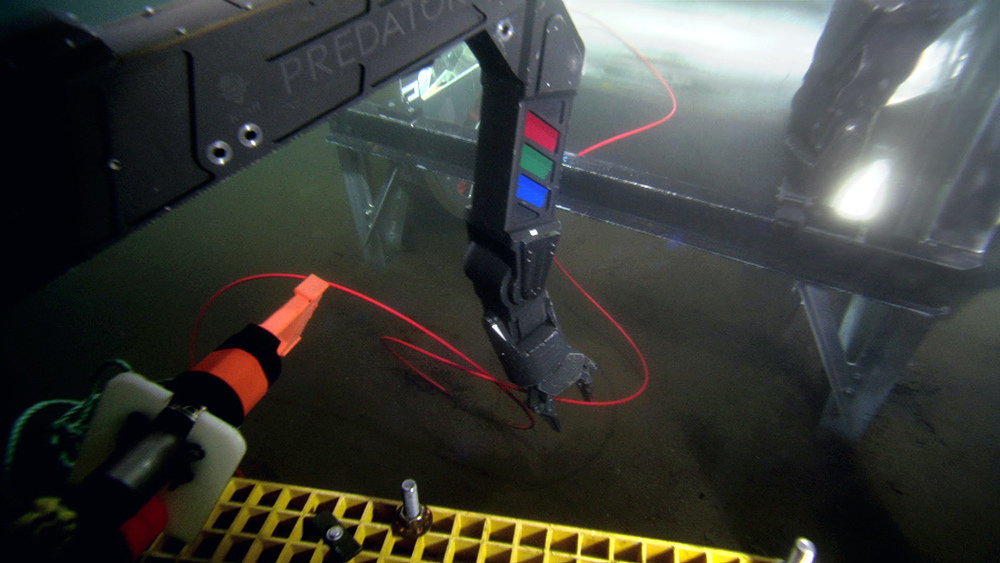
The Remotely Operated Platform for Ocean Sciences (ROPOS, Remotely Operated Ocean Research Platform - approx. Translator ) is a world-class underwater vehicle that can operate at depths of up to 5000 m. In this photo, it pulls a free cable out of its cable management system.
No problem, it's just data.
In cases where something goes wrong, NEPTUNE is very similar to any other computer network. Sometimes you just need to turn off everything and re-enable. Benoit Pyrene - the man who presses the switch.
Let's go back to the University of Victoria, where the Assistant Director of Digital Infrastructure stands in front of the monitor matrix, which occupies most of the wall. In fact, this impressive room is just a reception room, while most screens are displayed in offices and conference rooms of the building. On one of the displays that broadcast video from the Folger Reef, underwater vegetation is slowly rocking at the edge of the screen. On the other hand, the green, yellow and red indicators show the status of the NEPTUNE sensors, and also show whether the data is being received and recorded correctly.
Establishing communication between the coast and the system turned out to be no less difficult than laying the trunk cables and the secondary infrastructure of NEPTUNE. Luckily, Pyrene knows something about managing huge scientific computer systems. A tall Belgian computer scientist spent 18 years at the European Southern Observatory, managing data management and archiving systems, including those related to the Hubl telescope project.
Until recently, “The largest oceanographers used were ships,” Pyrene jokes, “But scientists have never had an observatory of this level yet.”
Pyrene and his five-member team spent nearly ten years writing software that helped NEPTUNE sensors to “talk”. Their job is to solve two problems: the first is to monitor the state of the network, just as system administrators do, the second is to ensure that the information sent by the sensors is correct and accurate.
In the network, there are about 130 devices, divided into 70 - 80 different categories: from high-resolution cameras to chemical sensors and hydrophones, each of which has many sensors that provide different information. Hydrophones and video cameras transmit audio and video data in real time, while other devices can only transmit one value every second. Sediment traps, for example, do not transmit any information at all, instead collecting physical samples on a schedule every second week.
Almost all actions related to NEPTUNE are carried out through sophisticated information management software - Oceans 2.0, which also acts as an interface. It displays each sensor, instrument, and junction box connected to all NEPTUNE nodes. Here you can find out information about the general state of the network, diagnose or restart problematic devices. Instead of using intelligent technology in the devices themselves, the “smart” component of the network is entirely concentrated in this software.
“We are ready to check the devices on a regular basis, twice a year, in weather favorable for swimming,” says Pyrene. “However, we wanted to make the core of the entire infrastructure as durable as possible because we have no desire to go under water, because repairs will be too expensive. ”The physical elements of the network were purposefully made very simple. The switches inside the nodes and junction boxes are occupied only by sending information back to shore, practically without performing any more complex functions.
On the shore, information from each instrument and NEPTUNE sensor is translated into regular formats for subsequent archiving and online display. Each measurement and reading is accompanied by time stamps, since it is not easy to synchronize the internal clock of each individual device with the rest of the network. Further, the information is processed and queued for analysis, on the basis of which the system decides how and where to display and save the results. There are also scripts that check information for accuracy, identifying instrument malfunctions and whether the data obtained fall within a possible range of values. There is even information about the instruments and sensors themselves - metadata that helps professionals understand the circumstances under which this or that information was collected. Here, for example,includes the age of the instrument and its past calibrations.
Pyrene says that according to his team’s calculations, data collected by NEPTUNE and other, smaller observatories at Ocean Networks Canada are performed daily for a total of 300 million operations, resulting in 250 GB of compressed and sent to storage data. Most of them are uncompressed audio recordings of the many hydrophones of the network. All this is stored and archived in the building of the University of Victoria, without the use of cloud technology. After saving, data is backed up to the University of Saskatchewan via a dedicated fiber optic channel. Since 2009, 250 TB of data have been archived in this way.
, , , , . Ocean Networks Canada , NEPTUNE, . , -. 99% . , .
. , , . , .
Soon: the sea will be even closer to you
NEPTUNE is one of the world's first underwater cable observatories. Still remaining the largest, today it is among the top three such systems located in Canada and managed by Ocean Networks Canada from the campus of the University of Victoria on Vancouver Island. The 50-km coastal observatory under the name VENUS has been operating since 2006, located between the island of Vancouver and the coast of British Columbia. At the end of 2012, the third small size observatory for the study of Arctic waters and ice was deployed in Cambridge Bay.
This fall, two hundred kilometers south of NEPTUNE, is planned to launch a smaller cable system called Regional Scale Nodes (RSN, regional scale nodes - translator’s comment). In the future, it is planned to connect the RSN with NEPTUNE, creating a huge international cable network covering the entire platform of Juan de Fuca. RSN is supervised by the Institute of Oceanography, led by Washington University Oceanographer John Delaney, the man who first predicted the emergence of underwater automated sensor systems.
- . , - . , , , , . , . , , , , 2 , . , . , .
You can often hear how, with some contempt, we are told that knowing so little about our own world, we are nonetheless fascinated by those beyond its boundaries. But we can always argue that only the barely opened, ghostly and neon-lit worlds lying at a depth of kilometers below us look as alien as the things we imagine about space. And then, finally, we turned on automation, crawlers, cameras and sensors to explore the depths of our own planet. Today we can safely say that the ocean has never been so accessible to people all over the world and has never been followed by such consistent, every minute observation.
, , , , , , , , - .
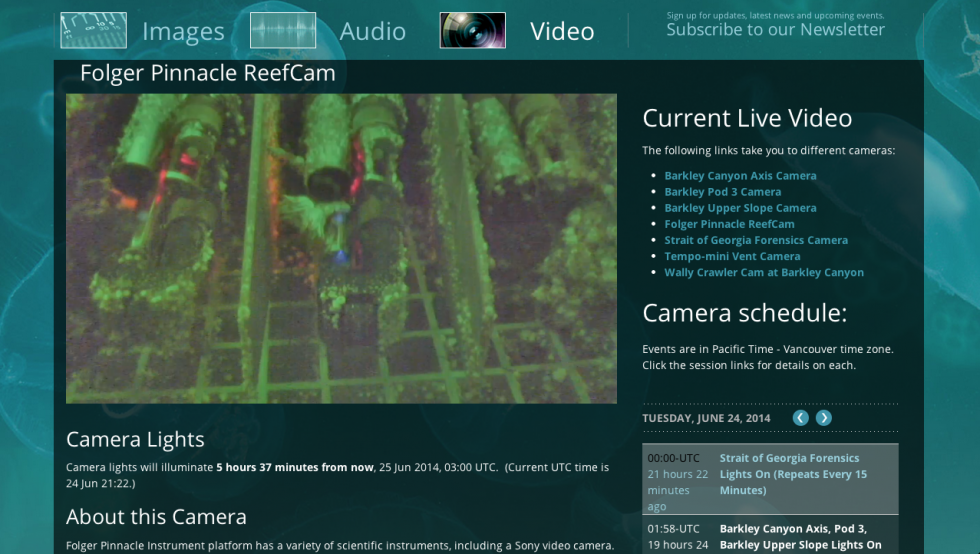
...

… .
Source: https://habr.com/ru/post/229091/
All Articles